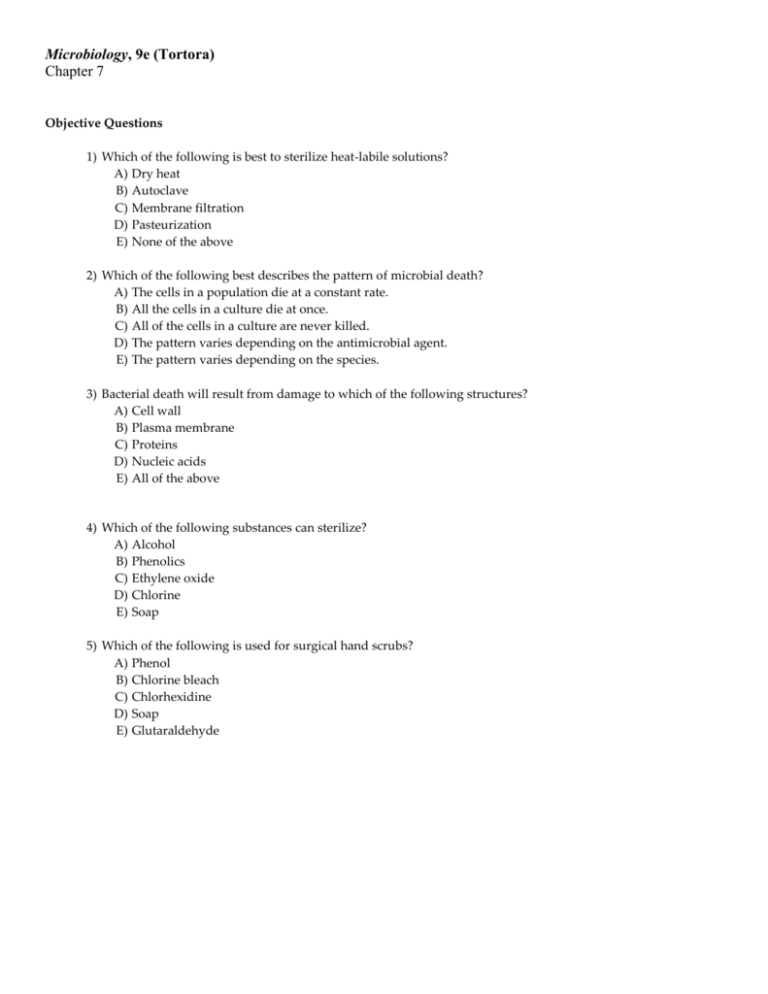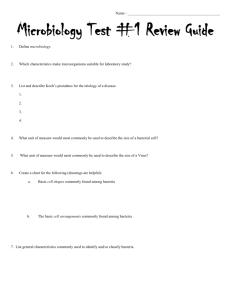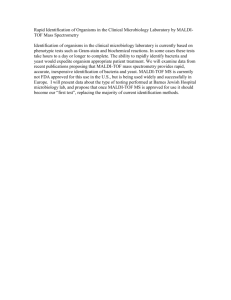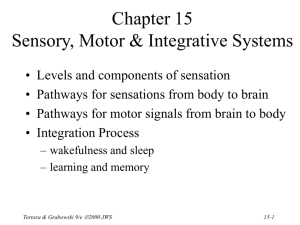Microbiology, 9e (Tortora) Chapter 7 Microbiology, 9e (Tortora
advertisement

Microbiology, 9e (Tortora) Chapter 7 Objective Questions 1) Which of the following is best to sterilize heat-labile solutions? A) Dry heat B) Autoclave C) Membrane filtration D) Pasteurization E) None of the above 2) Which of the following best describes the pattern of microbial death? A) The cells in a population die at a constant rate. B) All the cells in a culture die at once. C) All of the cells in a culture are never killed. D) The pattern varies depending on the antimicrobial agent. E) The pattern varies depending on the species. 3) Bacterial death will result from damage to which of the following structures? A) Cell wall B) Plasma membrane C) Proteins D) Nucleic acids E) All of the above 4) Which of the following substances can sterilize? A) Alcohol B) Phenolics C) Ethylene oxide D) Chlorine E) Soap 5) Which of the following is used for surgical hand scrubs? A) Phenol B) Chlorine bleach C) Chlorhexidine D) Soap E) Glutaraldehyde Microbiology, 9e (Tortora) Chapter 7 6) Which of the following is not a heavy metal? A) Silver nitrate B) Mercurochrome C) Merthiolate D) Copper sulfate E) Chlorine 7) Place the following surfactants in order from the most effective to the least effective antimicrobial activity: 1-Soap; 2-Anionic detergent; 3-Cationic detergent. A) 1, 2, 3 B) 1, 3, 2 C) 2, 1, 3 D) 3, 2, 1 E) 3, 1, 2 8) The antimicrobial activity of chlorine is due to which of the following? A) The formation of hypochlorous acid B) The formation of hydrochloric acid C) The formation of ozone D) The formation of free O E) Disruption of the plasma membrane 9) Iodophors differ from iodine (I2) in that iodophors A) B) C) D) E) Don't stain. Are less irritating. Are longer lasting. Are combined with a nonionic detergent. All of the above. 10) Phenolics differ from phenol in that phenolics are all of the following except A) Nonirritating. B) Relatively odorless. C) More effective antibacterial agents. D) More toxic to human cells. E) All of the above. Microbiology, 9e (Tortora) Chapter 7 11) Which of the following does not achieve sterilization? A) Dry heat B) Pasteurization C) Autoclave D) Formaldehyde E) Ethylene oxide 12) Which of the following is a limitation of the autoclave? A) Length of time B) Ability to inactivate viruses C) Ability to kill endospores D) Use with heat-labile materials E) Use with glassware 13) Which of the following affects the elimination of bacteria from an object? A) Number of bacteria present B) Temperature C) pH D) Presence of organic matter E) All of the above 14) Which of the following is not a direct result of heat? A) Breaking hydrogen bonds B) Breaking sulfhydryl bonds C) Denaturing enzymes D) Cell lysis E) None of the above 15) Which of the following substances is the least effective antimicrobial agent? A) Soap B) Cationic detergents C) Phenolics D) Iodine E) Alcohol Microbiology, 9e (Tortora) Chapter 7 16) Which of these disinfectants acts by denaturing proteins? A) Phenolics B) Aldehydes C) Halogens D) Alcohols E) All of the above 17) Which of these is not an oxidizing agent? A) Ozone B) Hydrogen peroxide C) Iodine D) Chlorine E) None of the above 18) Which of the following is not used for the disinfection of water? A) Ozone B) Gamma radiation C) Chlorine D) Copper sulfate E) None of the above 19) Which of the following is not effective against nonenveloped viruses? A) Alcohol B) Chlorine C) Ethylene oxide D) Ozone E) All are equally effective 20) Glutaraldehyde is considered one of the most effective disinfectants for hospital use. Which of the following would not be true about glutaraldehyde? A) Stains and corrodes. B) Safe to transport. C) Acts rapidly. D) Not hampered by organic material. E) Attacks all microorganisms. Microbiology, 9e (Tortora) Chapter 7 21) Which concentration of ethyl alcohol is the most effective bactericide? A) 100% B) 70% C) 50% D) 40% E) 30% 22) All of the following contribute to hospital-acquired infections except A) Some bacteria metabolize disinfectants. B) Gram-negative bacteria are often resistant to disinfectants. C) Invasive procedures can provide a portal of entry for bacteria. D) Bacteria may be present in commercial products such as mouthwash. E) None of the above. 23) Which of the following treatments is the most effective for controlling microbial growth? A) 63°C for 30 min. B) 72°C for 15 sec. C) 140°C for < 1 sec. D) They are equivalent treatments. E) None are effective. 24) Which of the following could be used to sterilize plastic Petri plates in a plastic wrapper? A) Microwaves B) Ultraviolet radiation C) Gamma radiation D) Sunlight E) None of the above 25) Which of the following treatments does not yield a sterile product? A) 0.45 μm filtration B) Autoclaving C) Gamma radiation D) Ionizing radiation E) 170°C for 2 hr Microbiology, 9e (Tortora) Chapter 7 Figure 7.1 26) In Figure 7.1, what is the thermal death time for culture a? A) 150°C B) 60 min. C) 120 min. D) 100°C E) Can't tell 27) Assume that one culture is a freshly opened package of dried yeast with 0.1% moisture, another culture is the same yeast with 7.5% moisture, and the third culture is a package of yeast mixed with water. Each culture was exposed to 130°C in a hot-air oven. Which graph in Figure 7.1 most likely shows the yeast with 0.1% moisture? A) a B) b C) c D) a and b E) b and c Microbiology, 9e (Tortora) Chapter 7 Figure 7.2 A suspension of 106 Bacillus cereus endospores was put in a hot-air oven at 170°C. Plate counts were used to determine the number of endospores surviving at the time intervals shown. 28) In Figure 7.2, the thermal death point for this culture is A) 15 min. B) 50°C. C) 30 min. D) 170°C. E) Can't tell from the data provided. 29) In Figure 7.2, the decimal reduction time (D value) for the culture is approximately A) 0 min. B) 15 min. C) 30 min. D) 45 min. E) 60 min. 30) In Figure 7.2, the thermal death time for this culture is A) 0 min. B) 10 min. C) 20 min. D) 40 min. E) 60 min. Microbiology, 9e (Tortora) Chapter 7 31) Which of the following pairs is not correctly matched? A) Ag burns B) Merthiolate open wounds C) CuSO4 algicide D) H2O2 open wounds E) None of the above Figure 7.3 Assume 109 E. coli cells/ml are in a flask. 32) Which graph in Figure 7.3 best depicts the effect of placing the culture in an autoclave for 15 min. at time x? A) a B) b C) c D) d E) e 33) Which graph in Figure 7.3 best depicts the effect of placing the culture at 7°C at time x? A) a B) b C) c D) d E) e Microbiology, 9e (Tortora) Chapter 7 Table 7.1 A disk-diffusion test using Staphylococcus gave the following results: Disinfectant A B C D Zone of inhibition (mm) 0 2.5 10 5 34) In Table 7.1, which compound was the most effective against Staphylococcus? A) A B) B C) C D) D E) Can't tell 35) In Table 7.1, which compound was the most effective against E. coli? A) A B) B C) C D) D E) Can't tell 36) In Table 7.1, which compound was bactericidal? A) A B) B C) C D) D E) Can't tell Microbiology, 9e (Tortora) Chapter 7 Table 7.2 The fate of E. coli O157:H7 in apple cider held at 8°C for 2 weeks, with and without preservatives, is shown below: Cider only Cider with potassium sorbate Sodium benzoate Sorbate + benzoate 37) In Table 7.2, which preservative is most effective? A) Sorbate B) Benzoate C) Sorbate + benzoate D) No preservative 38) Which one of the following does not belong with the others? A) Acid-anionic detergents B) Benzoic acid C) Commercial sterilization D) Pasteurization E) Sorbic acid 39) Which one of the following does not belong with the others? A) Beta-propiolactone B) Glutaraldehyde C) Ethylene oxide D) Hydrogen peroxide E) Propylene oxide 40) Foods are preserved with all of the following except A) Biguanides. B) Nisin. C) Potassium sorbate. D) Sodium nitrite. E) Sodium propionate. Bacteria/ml 2.2 2.0 0 0 Microbiology, 9e (Tortora) Chapter 7 41) Which one of the following is most useful for disinfecting medical instruments? A) Benzoic acid B) Bisphenols C) Chlorine D) Phenol E) Quats Table 7.3 The following data were obtained by incubating the bacteria in nutrient medium + disinfectant for 24 hr, then transferring one loopful to nutrient medium (subculturing.) Doom K.O. Dilution 1:16 1:32 1:64 1:128 Initial + Subculture + + + + Dilution 1:16 1:32 1:64 1:128 Mortum Initial Subculture + + + + + Initial + + + + Subculture + + + + Sterl Initial + + + Subculture + + + + 42) In Table 7.3, which disinfectant is the most effective at stopping bacterial growth? A) Doom B) K.O. C) Mortum D) Sterl E) Can't tell 43) In Table 7.3, which disinfectant was bactericidal? A) Doom B) K.O. C) Mortum D) Sterl E) Can't tell Microbiology, 9e (Tortora) Chapter 7 44) In Table 7.3, which disinfectant was most effective against Salmonella? A) Doom B) K.O. C) Mortum D) Sterl E) Can't tell 45) Which one of the following is most resistant to chemical biocides? A) Gram-negative bacteria B) Gram-positive bacteria C) Mycobacteria D) Protozoan cysts E) Viruses with lipid envelopes








